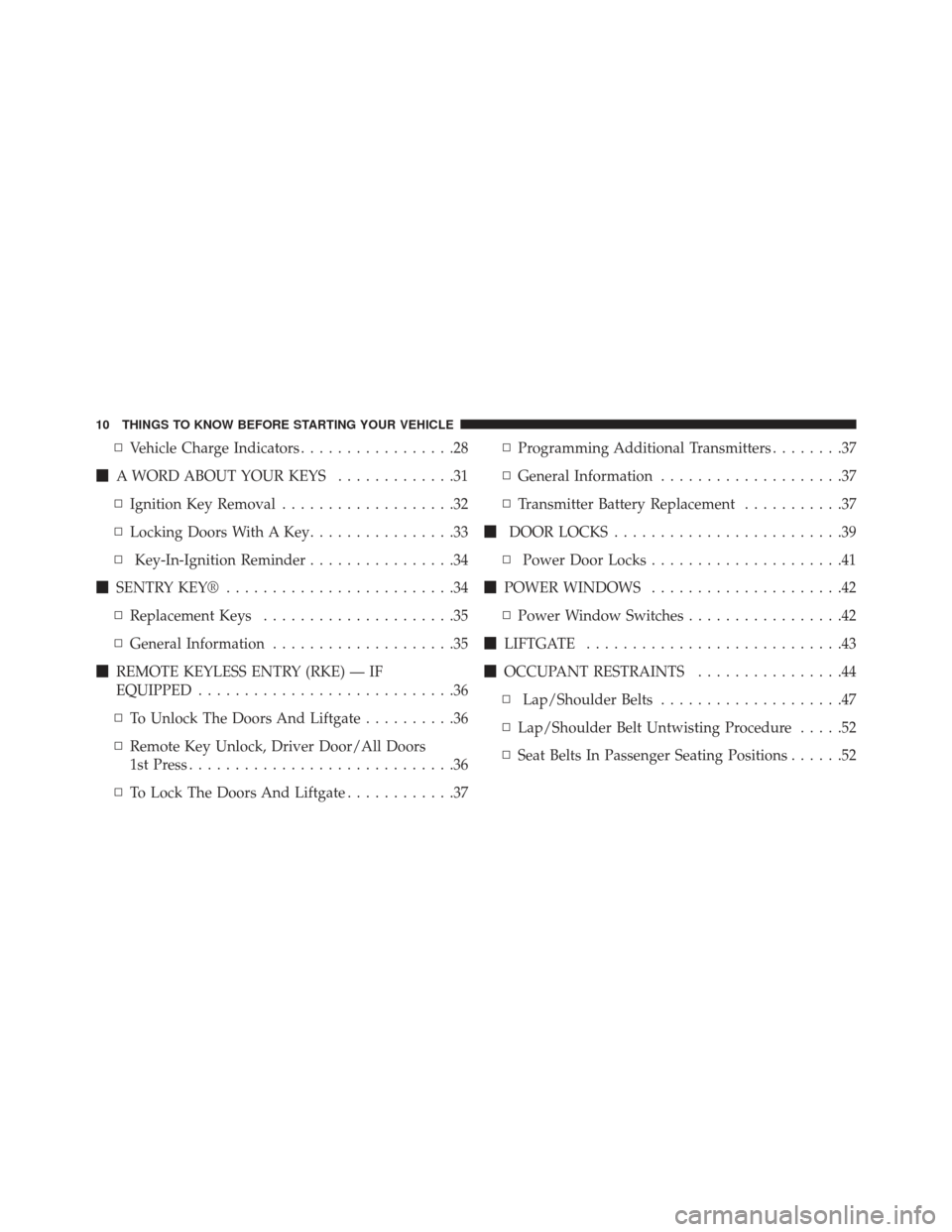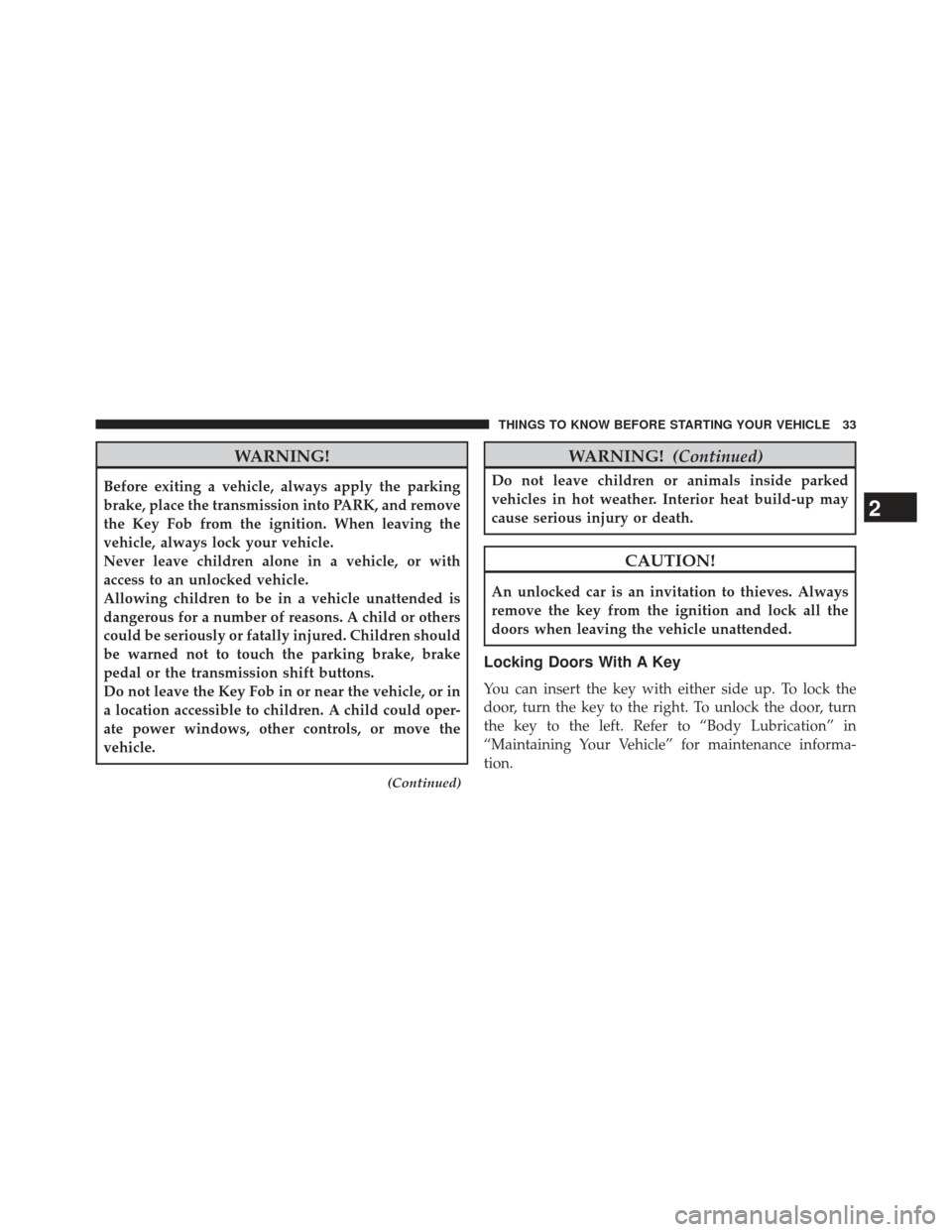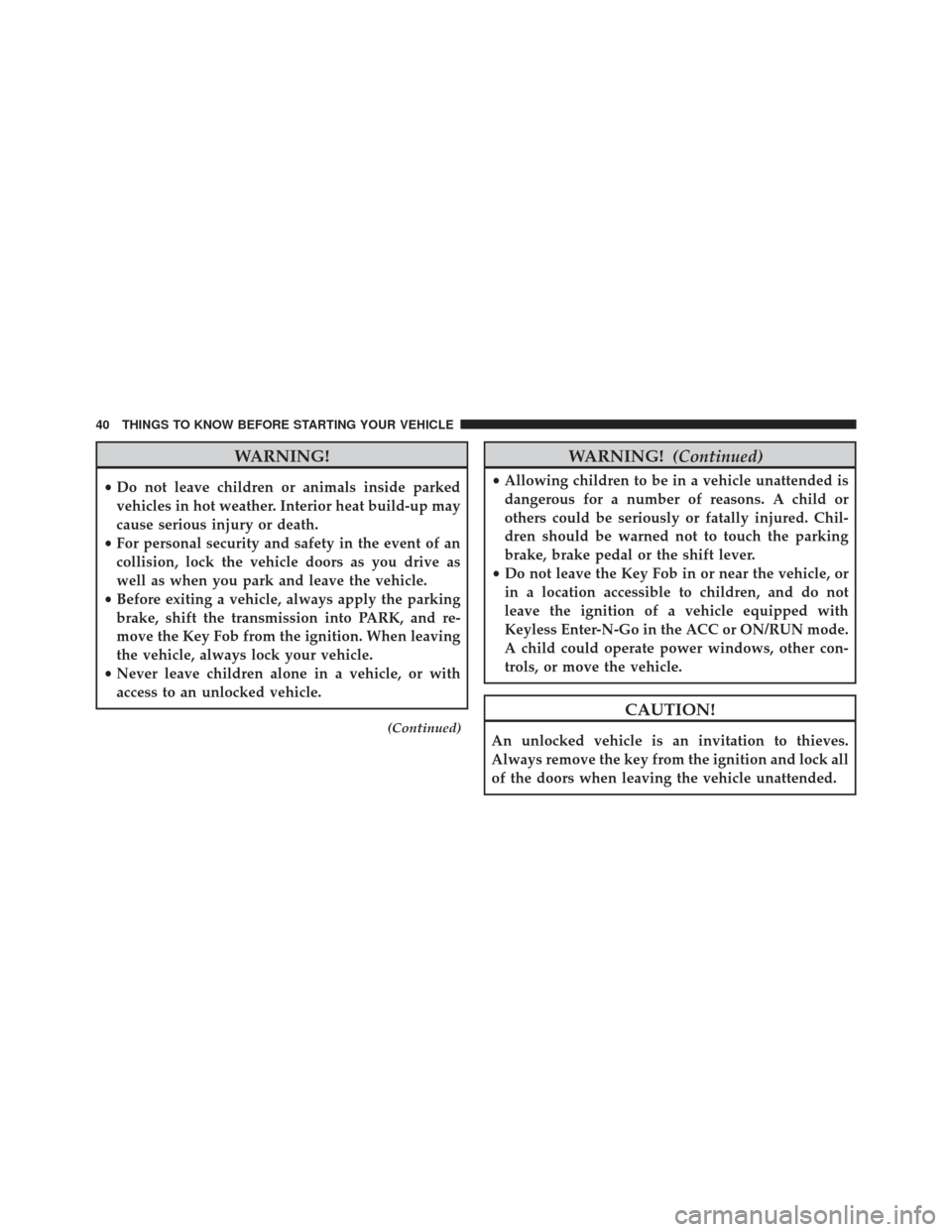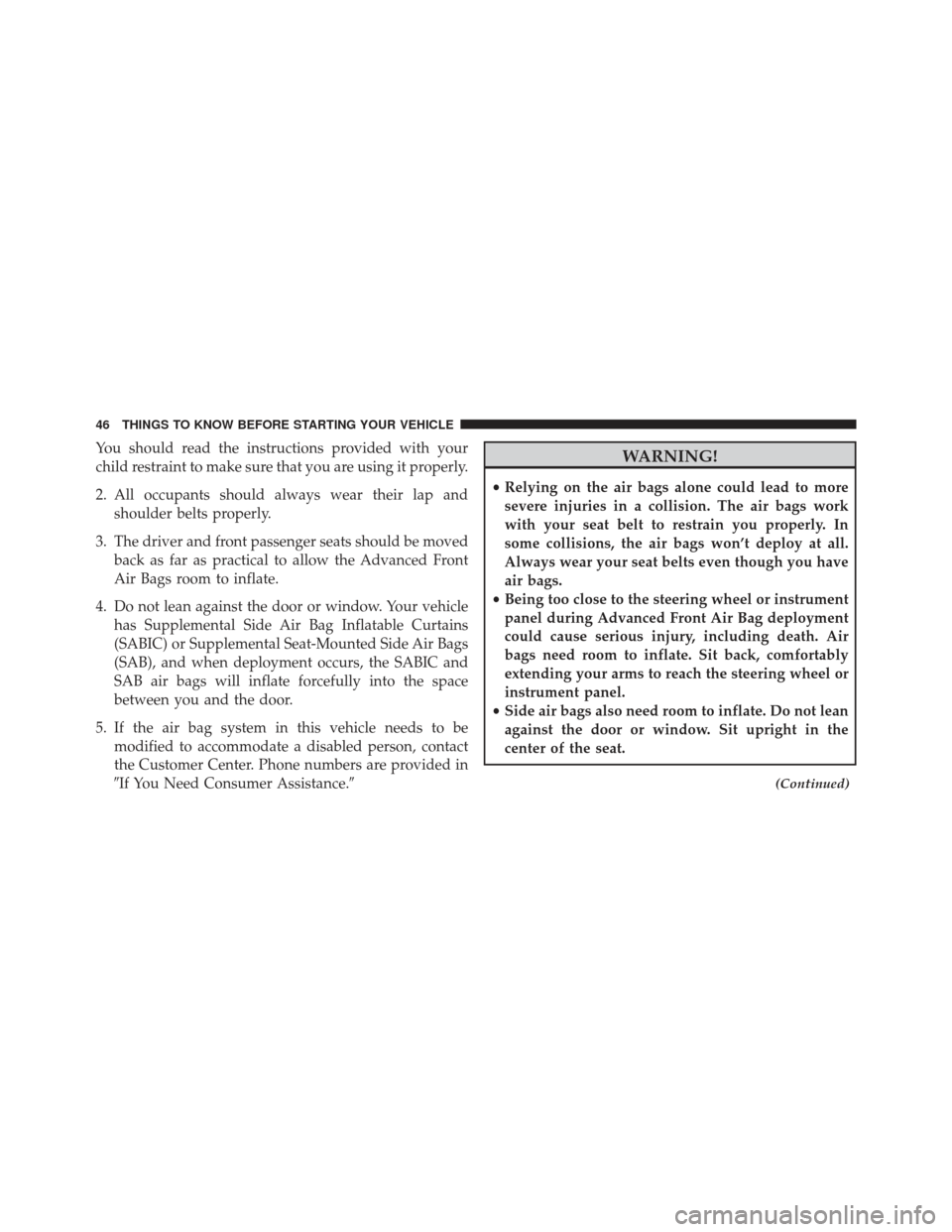Page 12 of 350

▫Vehicle Charge Indicators .................28
� A WORD ABOUT YOUR KEYS .............31
▫ Ignition Key Removal ...................32
▫ Locking Doors With A Key ................33
▫ Key-In-Ignition Reminder ................34
� SENTRY KEY® .........................34
▫ Replacement Keys .....................35
▫ General Information ....................35
� REMOTE KEYLESS ENTRY (RKE) — IF
EQUIPPED ............................36
▫ To Unlock The Doors And Liftgate ..........36
▫ Remote Key Unlock, Driver Door/All Doors
1stPress.............................36
▫ To Lock The Doors And Liftgate ............37▫
Programming Additional Transmitters ........37
▫ General Information ....................37
▫ Transmitter Battery Replacement ...........37
� DOOR LOCKS .........................39
▫ Power Door Locks .....................41
� POWER WINDOWS .....................42
▫ Power Window Switches .................42
� LIFTGATE ............................43
� OCCUPANT RESTRAINTS ................44
▫ Lap/Shoulder Belts ....................47
▫ Lap/Shoulder Belt Untwisting Procedure .....52
▫ Seat Belts In Passenger Seating Positions ......52
10 THINGS TO KNOW BEFORE STARTING YOUR VEHICLE
Page 35 of 350

WARNING!
Before exiting a vehicle, always apply the parking
brake, place the transmission into PARK, and remove
the Key Fob from the ignition. When leaving the
vehicle, always lock your vehicle.
Never leave children alone in a vehicle, or with
access to an unlocked vehicle.
Allowing children to be in a vehicle unattended is
dangerous for a number of reasons. A child or others
could be seriously or fatally injured. Children should
be warned not to touch the parking brake, brake
pedal or the transmission shift buttons.
Do not leave the Key Fob in or near the vehicle, or in
a location accessible to children. A child could oper-
ate power windows, other controls, or move the
vehicle.
(Continued)
WARNING!(Continued)
Do not leave children or animals inside parked
vehicles in hot weather. Interior heat build-up may
cause serious injury or death.
CAUTION!
An unlocked car is an invitation to thieves. Always
remove the key from the ignition and lock all the
doors when leaving the vehicle unattended.
Locking Doors With A Key
You can insert the key with either side up. To lock the
door, turn the key to the right. To unlock the door, turn
the key to the left. Refer to “Body Lubrication” in
“Maintaining Your Vehicle” for maintenance informa-
tion.
2
THINGS TO KNOW BEFORE STARTING YOUR VEHICLE 33
Page 42 of 350

WARNING!
•Do not leave children or animals inside parked
vehicles in hot weather. Interior heat build-up may
cause serious injury or death.
• For personal security and safety in the event of an
collision, lock the vehicle doors as you drive as
well as when you park and leave the vehicle.
• Before exiting a vehicle, always apply the parking
brake, shift the transmission into PARK, and re-
move the Key Fob from the ignition. When leaving
the vehicle, always lock your vehicle.
• Never leave children alone in a vehicle, or with
access to an unlocked vehicle.
(Continued)
WARNING! (Continued)
•Allowing children to be in a vehicle unattended is
dangerous for a number of reasons. A child or
others could be seriously or fatally injured. Chil-
dren should be warned not to touch the parking
brake, brake pedal or the shift lever.
• Do not leave the Key Fob in or near the vehicle, or
in a location accessible to children, and do not
leave the ignition of a vehicle equipped with
Keyless Enter-N-Go in the ACC or ON/RUN mode.
A child could operate power windows, other con-
trols, or move the vehicle.
CAUTION!
An unlocked vehicle is an invitation to thieves.
Always remove the key from the ignition and lock all
of the doors when leaving the vehicle unattended.
40 THINGS TO KNOW BEFORE STARTING YOUR VEHICLE
Page 44 of 350

To change the setting proceed as follows:
1. Briefly press theSET ESCbutton “On” or “Off” will
flash on the display (according to the previous set-
ting).
2. Press the UP
or DOWNbutton for setting.
3. Briefly press the SET ESCbutton to go back to the
menu screen, or press and hold the SET ESCbutton
(approximately one second) to go back to the main
screen without storing the settings.
NOTE: Use the Automatic Door Locks feature in accor-
dance with local laws.
Refer to “Electronic Vehicle Information Center (EVIC)”
in “Understanding Your Vehicle” for further information.
POWER WINDOWS
Power Window Switches
There are single window controls located on the shifter
bezel, below the climate controls, which operate the
driver and passenger door windows. The window con-
trols will operate when the ignition switch is in the
ON/RUN position.
WARNING!
Never leave children unattended in a vehicle, and do
not let children play with power windows. Do not
leave the key fob in or near the vehicle. Occupants,
particularly unattended children, can become en-
trapped by the windows while operating the power
window switches. Such entrapment may result in
serious injury or death.
42 THINGS TO KNOW BEFORE STARTING YOUR VEHICLE
Page 45 of 350
Auto-Down — If Equipped
The driver’s door window switch may have an Auto-
Down feature. Press the window switch for approxi-
mately one second, release, and the window will godown automatically. To cancel the Auto-Down move-
ment, operate the switch in either the up or down
direction and release the switch.
Wind Buffeting
Wind buffeting can be described as the perception of
pressure on the ears or a helicopter-type sound in the
ears. Your vehicle may exhibit wind buffeting with the
windows down, or the sunroof (if equipped) in certain
open or partially open positions. This is a normal occur-
rence and can be minimized. If the buffeting occurs with
the sunroof open, adjust the sunroof opening to minimize
the buffeting or open any window.
LIFTGATE
To unlock the liftgate, use the Remote Keyless Entry
(RKE) transmitter or activate the power door lock
switches located on the front door handles.
Power Window Switches
2
THINGS TO KNOW BEFORE STARTING YOUR VEHICLE 43
Page 46 of 350
To open the liftgate, squeeze the liftgate release handle
and pull the liftgate open with one fluid motion.
Gas props support the liftgate in the open position.
However, because the gas pressure drops with tempera-
ture, it may be necessary to assist the props when
opening the liftgate in cold weather.OCCUPANT RESTRAINTS
Some of the most important safety features in your
vehicle are the restraint systems:
•Three-point lap and shoulder belts for all seating
positions
• Advanced Front Air Bags for driver and front passen-
ger
• Supplemental Driver Side Knee Air Bag
• Supplemental Side Air Bag Inflatable Curtains (SABIC)
for the driver and passengers seated next to a window
• Supplemental Seat-Mounted Side Air Bags (SAB)
• Knee bolsters/blockers for front seat occupants
• Front seat belts incorporate pretensioners that may
enhance occupant protection by managing occupant
energy during an impact event
Liftgate Handle
44 THINGS TO KNOW BEFORE STARTING YOUR VEHICLE
Page 48 of 350

You should read the instructions provided with your
child restraint to make sure that you are using it properly.
2. All occupants should always wear their lap andshoulder belts properly.
3. The driver and front passenger seats should be moved back as far as practical to allow the Advanced Front
Air Bags room to inflate.
4. Do not lean against the door or window. Your vehicle has Supplemental Side Air Bag Inflatable Curtains
(SABIC) or Supplemental Seat-Mounted Side Air Bags
(SAB), and when deployment occurs, the SABIC and
SAB air bags will inflate forcefully into the space
between you and the door.
5. If the air bag system in this vehicle needs to be modified to accommodate a disabled person, contact
the Customer Center. Phone numbers are provided in
�If You Need Consumer Assistance.�WARNING!
•Relying on the air bags alone could lead to more
severe injuries in a collision. The air bags work
with your seat belt to restrain you properly. In
some collisions, the air bags won’t deploy at all.
Always wear your seat belts even though you have
air bags.
• Being too close to the steering wheel or instrument
panel during Advanced Front Air Bag deployment
could cause serious injury, including death. Air
bags need room to inflate. Sit back, comfortably
extending your arms to reach the steering wheel or
instrument panel.
• Side air bags also need room to inflate. Do not lean
against the door or window. Sit upright in the
center of the seat.
(Continued)
46 THINGS TO KNOW BEFORE STARTING YOUR VEHICLE
Page 60 of 350

and rear passengers sitting next to a window. The SABIC
are located above the side windows. The trim covering
the SABIC is labeled SRS AIRBAG.
This vehicle is equipped with Supplemental Seat-
Mounted Side Air Bags (SAB). The SAB are marked with
an air bag label sewn into the outboard side of the front
seats.
NOTE:
•Air Bag covers may not be obvious in the interior trim,
but they will open during air bag deployment.
• After any collision, the vehicle should be taken to an
authorized studio immediately.
Air Bag System Components
Your vehicle may be equipped with the following air bag
system components:
• Occupant Restraint Controller (ORC) •
Air Bag Warning Light
• Steering Wheel and Column
• Instrument Panel
• Supplemental Driver Side Knee Air Bag
• Knee Impact Bolsters
• Driver Advanced Front Air Bag
• Passenger Advanced Front Air Bag
• Supplemental Seat-Mounted Side Air Bags (SAB)
• Supplemental Side Air Bag Inflatable Curtains (SABIC)
• Front and Side Impact Sensors
• Front Seat Belt Pretensioners, Seat Belt Buckle Switch,
and Seat Track Position Sensors
58 THINGS TO KNOW BEFORE STARTING YOUR VEHICLE